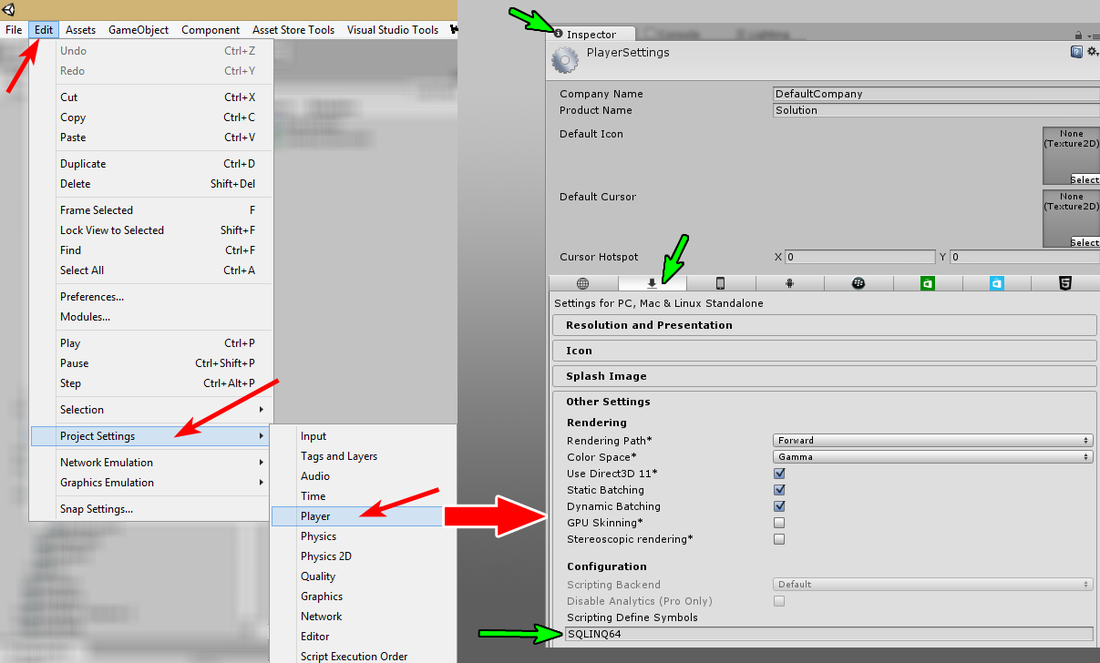SQLINQ - Getting started
This section assumes you have gone through the majority of the tutorial videos and want to see how difficult it is to create code. The entire idea behind SQLINQ is the ability to quickly go from a model to code with few steps in the middle. Assuming your model has all the right features, or the Bridge you are using is well written, you should be able to straight to coding once the code is generated.
All the pre-written and generated classes are designed to hide away the complexities of dealing with SQLite. There are a few things you have to do to read data and/or write data.
All the pre-written and generated classes are designed to hide away the complexities of dealing with SQLite. There are a few things you have to do to read data and/or write data.
Setting the 32-bit vs. 64-bit SQLITE DLL
Both Windows and OSX use the same Dynamic Link Library (DLL). The versions are acquired here:
Both versions are included in the plugins folder, but in case you need to upgrade, this the original sourced locations.
Important Note: If you are using a 32-bit or 64-bit SQLite version, you must set a compiler flag in player settings. These Compiler Flags tells SQLINQ which version of SQLite to bind to and correspondingly which library it will use:
- 32-Bit: http://sqlite.org/download.html (Look for the "32-bit DLL (x86) for SQLite verison 3.8.8.3" link)
- 64-Bit: http://blog.synopse.info/post/2013/03/23/Latest-version-of-sqlite3.dll-for-Windows-64-bit
Both versions are included in the plugins folder, but in case you need to upgrade, this the original sourced locations.
Important Note: If you are using a 32-bit or 64-bit SQLite version, you must set a compiler flag in player settings. These Compiler Flags tells SQLINQ which version of SQLite to bind to and correspondingly which library it will use:
- Use SQLINQ32 to use the 32-bit version of SQLite
- Use SQLINQ64 to use the 64-bit version of SQLite (the image below shows the setting of the 64-bit compiler flag)
Factory Initialize
Factory.Initialize();
This class and static method is generated by SQLINQ and it's purpose is to initialize the repository with information about how to transform rows coming out of a database into the objects represented by your class model.
This method is only required if you are reading from SQLite, and must be called before your first object is read. It often appears in an "Awake()" method, and it's smart, in that if you accidentally call the method more than once, it exits on the subsequent tries.
Note: It's not required if you are only writing objects to the database.
This class and static method is generated by SQLINQ and it's purpose is to initialize the repository with information about how to transform rows coming out of a database into the objects represented by your class model.
This method is only required if you are reading from SQLite, and must be called before your first object is read. It often appears in an "Awake()" method, and it's smart, in that if you accidentally call the method more than once, it exits on the subsequent tries.
Note: It's not required if you are only writing objects to the database.
initialize repository
Repository.InitializeRepository("filename");
This method is required to identify the physical file on the end-users hard-drive. SQLite has no association to a specific file extension (Windows), it simply uses the file as a place to put it's database.
SQLite's database is fully self-contained within this file. That means it makes it possible to create temporary copies of the database so that a game could read/write out of the copy and then the game could write it back to it's main location with a game save. SQLINQ doesn't normally keep a file open when writing to the database, so it's possible to copy the file using .Net's File.Copy() method to "save" the database.
The only difference between OSX and Windows users is the filename; otherwise the system is functionally identical.
This method is required to identify the physical file on the end-users hard-drive. SQLite has no association to a specific file extension (Windows), it simply uses the file as a place to put it's database.
SQLite's database is fully self-contained within this file. That means it makes it possible to create temporary copies of the database so that a game could read/write out of the copy and then the game could write it back to it's main location with a game save. SQLINQ doesn't normally keep a file open when writing to the database, so it's possible to copy the file using .Net's File.Copy() method to "save" the database.
The only difference between OSX and Windows users is the filename; otherwise the system is functionally identical.
factory make database
Factory.MakeDatabase();
You call this method whenever you are creating a database for the first time. It constructs the tables and indexes in an ordered fashion. If you modify the underlying classes SQLINQ will retrofit the database to fit the new data structure, but won't remove columns you removed from your definitions. You can create individual tables by calling Table.CreateTable() directly.
You will have to write your own code to retrofit existing tables with new tables yourself, which includes the manual removal of data.
You call this method whenever you are creating a database for the first time. It constructs the tables and indexes in an ordered fashion. If you modify the underlying classes SQLINQ will retrofit the database to fit the new data structure, but won't remove columns you removed from your definitions. You can create individual tables by calling Table.CreateTable() directly.
You will have to write your own code to retrofit existing tables with new tables yourself, which includes the manual removal of data.
Suggested tools
Once you have your data, you may want to look at the database or edit the data. See the External Websites page for suggested (free) tools.
